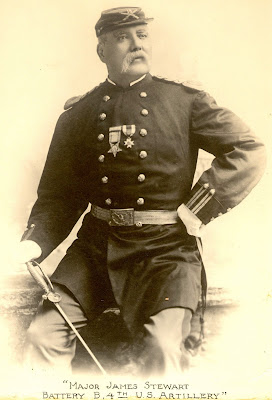Private James S. Armstrong was born in Canada about 1845 one of seven children of mill wright Thomas and Phoebe (Turner) Armstrong. In 1855 the family lived in Ramsen, Oneida County, New York. By 1860 they had settled in Trimbelle,Pierce County, Wisconsin. James enlisted in Company B, 6th Wisconsin Volunteer Infantry Regiment on June 6, 1861 following in his brother Edgar's footsteps, edgar having enlisted on May 10, 1861 in the 6th Wisconsin. James Armstrong was detached to serve with Battery B 4th U. S. Artillery on December 1, 1861. He was serving with the battery at Antietam when he was wounded September 17, 1862. James would be discharged for disability October 25, 1862. After being discharged he would return to Trimbelle where he died November 10, 1862. Private Armstrong is buried in the Trimbelle Cemetery Pierce County, Wisconsin. Jame's brother Edgar would serve with Battery B from December 1, 1861 until mustering out of federal service on July 15, 1864. Edgar would live until November 6, 1910.
Private Isaac Sourwine enlisted in Company E, 19th Indiana Volunteer Infantry Regiment of July 29, 1861. Isaac, who was born November 14, 1841 in Cross Roads, Delaware County, Indiana was the son of Virginians Christian Souerwine and his second wife Catherine. By 1860 Isaac and his father were residents of Bear Creek, Poweshiek County, Iowa. Private Sourwine was detached from the 19th Indiana on November 1861, volunteering to serve with Battery B. He was wounded by a shell fragment in the left leg during the Battle of Antietam. On September 28, 1862 he was admitted to General Hospital No. 6 in Frederick, Maryland. He was discharged for disability on December 2, 1862 at Frederick. Isaac would return to Indiana after his discharge. In July 1863 he enlisted for 10 days in Company F, 110th Indiana Volunteer Infantry. He later enlisted as a sergeant in Company G 7th Indiana Cavalry From September 5, 1863 until September 19, 1865. On June 12, 1866 Isaac married Margaret Susannah Clevenger in Indiana. In the 1870 & 1880 Census the family was living in Monroe, Delaware County, Indiana where Isaac was listed as a farmer. The couple would eventually have 6 children, 2 daughters and 4 sons. By 1900 Isaac and Margaret were living in Jackson, Wells County, Indiana. Isaac would die of throat cancer April 22, 1906. Margaret would out live him by about 11 years dying in1917. Isaac and Margaret are buried in Jones Cemetery, Wells County, Indiana.
Isaac Sowerwine Headstone (Find A grave photo by NLBMZ)
John H. McLaughlin, a son of John and Mary A. (Walker) McLaughlin was born in Pennsylvania in March 1836. He was living in Trimbelle, Pierce County, Wisconsin when he enlisted as a private in Company B,of the 6th Wisconsin. He would be detached to Battery B June 7, 1862 and would serve with it until mustering out of the service July 15, 1864. McLaughlin was wounded at Antietam. John married Elizabeth K. (Beardsley) September 10, 1865 at Oak Grove, Pierce County, Wisconsin. In 1870 the family lived in Trimbelle where John was a cooper. By 1880 he was farming and also served as the Trimbelle town treasurer. John & Elizabeth would have three daughters, Ella, Lulu and Maud. 1900 would find John and Elizabeth residing in Clear Lake, Skagit County, Washington with at least one of their daughters. John McLaughlin died on October 21, 1909 age 73. He is buried in the Clear Lake Cemetery in Skagit County, Washington.
John McLaughlin Headstone (Find A Grave photo by Mostloved)
John Holland was born in New York, February 24, 1833, the son of Irish immigrant parents. John was a resident of Oshkosh, Wisconsin when he enlisted in Company E, 2nd Wisconsin Infantry of May 18, 1861. Private Holland was detailed to Battery B September 15, 1862. He would remain on detached service until May 9, 1864. Holland would be wounded in action at Antietam and Gettysburg. He mustered out of federal service on July 14, 1865. John Holland would marry Harriet Mull in Shawano County, Wisconsin on July 4, 1870. Their son Abraham was born in February 1872. The 1880 Census shows the family living in Alma, Jackson County, Wisconsin. John was listed as a laborer. By 1900, when John was 67, John, Harriet and Abraham were living in Summit, Langlade County, Wisconsin where John was a farmer and Abraham a farm laborer. John Holland died in Summit, Wisconsin December 25, 1917. He is buried in Gleason Cemetery, in Lincoln County, Wisconsin. His headstone notes he served with the 2nd Wisconsin and Battery b 4th U. S. Artillery.
John Holland Headstone (Find A Grave photo by Kizzie)
Information in this post is obtained mostly from U. S. Census records, Regimental Rosters, Pension Indexes, Headstones Provided for Deceased Union Civil War Veterans, U. S. National Home for Disabled Volunteers records, Registers of Deaths of Volunteers, New York, Town Clerks Register of Men Who Served in the Civi War. Giants in Their Tall Black Hats, and other Civil war related Records on Ancestry.com and Fold3.com.





